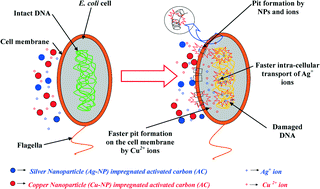当前位置:
X-MOL 学术
›
Environ. Sci.: Nano
›
论文详情
Our official English website, www.x-mol.net, welcomes your feedback! (Note: you will need to create a separate account there.)
Synergistic antibacterial activity of a combination of silver and copper nanoparticle impregnated activated carbon for water disinfection†
Environmental Science: Nano ( IF 7.3 ) Pub Date : 2017-10-06 00:00:00 , DOI: 10.1039/c7en00427c Pritam Biswas 1, 2, 3, 4 , Rajdip Bandyopadhyaya 1, 2, 3, 4
Environmental Science: Nano ( IF 7.3 ) Pub Date : 2017-10-06 00:00:00 , DOI: 10.1039/c7en00427c Pritam Biswas 1, 2, 3, 4 , Rajdip Bandyopadhyaya 1, 2, 3, 4
Affiliation

|
Silver and copper nanoparticles impregnated separately on plasma-treated activated carbon (AC) (named Ag-AC and Cu-AC, respectively), when mixed in an optimized 50 : 50 weight ratio, show synergistic water disinfection compared to only Ag-AC or only Cu-AC. Time-dependent cryo-SEM imaging and reactive oxygen species (ROS) measurement of E. coli prove that (in both batch mode and continuous flow column) Cu-AC forms pits faster on the cell membrane compared to Ag-AC and together with the latter facilitates faster cell death. The composite of Ag-AC and Cu-AC in batch mode showed a 4 log reduction of live E. coli cells in the treated water in 8 minutes, as confirmed by both plate count and fluorescence spectroscopy. Scaling up this result in a continuous flow column (of 8 cm diameter and 25 cm height, packed with the composite), one could achieve zero live cell concentration in only 7 minutes of contact time, translating into a very high flow rate of 5.32 L h−1 of treated water. Therefore, plate count, fluorescence spectroscopy, time-dependent ROS measurement and cryo-SEM imaging establish the mechanism of synergy and contact time required for cell death. The disinfection performance to zero live E. coli cells could be maintained with an even higher inlet E. coli concentration of 106 CFU ml−1 (albeit at a lower throughput from the column, as expected) and also non-stop for at least 5 days, demonstrating a potential long-term performance, with more than adequate Ag and Cu left in the column. Finally, the steady state concentrations of Ag and Cu in the treated water were 23 and 56.4 μg L−1, respectively, which are well within the permissible limits of 100 and 1000 μg L−1 for Ag and Cu, respectively. Therefore, the synergistic antibacterial activity of the composite resulted in production of decontaminated water at the highest throughput over a long time period.
中文翻译:

银和铜纳米颗粒浸渍的活性炭组合对水消毒的协同抗菌作用†
当以优化的50:50重量比混合时,分别浸渍在等离子处理的活性炭(AC)(分别命名为Ag-AC和Cu-AC)上的银和铜纳米粒子与仅使用Ag-AC或Al-AC相比,显示出协同的水消毒效果。只有Cu-AC。随时间变化的低温SEM成像和大肠杆菌的活性氧(ROS)测量证明(在分批模式和连续流色谱柱中),Cu-AC与Ag-AC相比,在细胞膜上形成凹坑的速度更快,并且与后者促进更快的细胞死亡。批处理模式下的Ag-AC和Cu-AC的复合物显示活大肠杆菌减少了4 log平板计数和荧光光谱均证实,在8分钟内,处理过的水中存在细胞。将此结果放大到连续流动的色谱柱中(直径为8 cm,高度为25 cm,填充有复合物),可以在仅7分钟的接触时间内实现零活细胞浓度,转化为5.32 L的极高流速h -1处理过的水。因此,板计数,荧光光谱,随时间变化的ROS测量和低温SEM成像建立了细胞死亡所需的协同作用和接触时间的机制。更高的进口大肠杆菌浓度为10 6 CFU ml -1时,可以维持对零活大肠杆菌细胞的消毒性能。(尽管预期的那样,色谱柱的通量较低),并且至少连续5天不停机,这表明了其潜在的长期性能,其中足够的Ag和Cu留在色谱柱中。最后,经处理的水中的Ag和Cu的稳态浓度分别为23和56.4μgL -1,这分别在Ag和Cu的100和1000μgL -1的允许极限内。因此,复合物的协同抗菌活性导致在较长的时间内以最高的通量生产去污水。
更新日期:2017-10-06
中文翻译:

银和铜纳米颗粒浸渍的活性炭组合对水消毒的协同抗菌作用†
当以优化的50:50重量比混合时,分别浸渍在等离子处理的活性炭(AC)(分别命名为Ag-AC和Cu-AC)上的银和铜纳米粒子与仅使用Ag-AC或Al-AC相比,显示出协同的水消毒效果。只有Cu-AC。随时间变化的低温SEM成像和大肠杆菌的活性氧(ROS)测量证明(在分批模式和连续流色谱柱中),Cu-AC与Ag-AC相比,在细胞膜上形成凹坑的速度更快,并且与后者促进更快的细胞死亡。批处理模式下的Ag-AC和Cu-AC的复合物显示活大肠杆菌减少了4 log平板计数和荧光光谱均证实,在8分钟内,处理过的水中存在细胞。将此结果放大到连续流动的色谱柱中(直径为8 cm,高度为25 cm,填充有复合物),可以在仅7分钟的接触时间内实现零活细胞浓度,转化为5.32 L的极高流速h -1处理过的水。因此,板计数,荧光光谱,随时间变化的ROS测量和低温SEM成像建立了细胞死亡所需的协同作用和接触时间的机制。更高的进口大肠杆菌浓度为10 6 CFU ml -1时,可以维持对零活大肠杆菌细胞的消毒性能。(尽管预期的那样,色谱柱的通量较低),并且至少连续5天不停机,这表明了其潜在的长期性能,其中足够的Ag和Cu留在色谱柱中。最后,经处理的水中的Ag和Cu的稳态浓度分别为23和56.4μgL -1,这分别在Ag和Cu的100和1000μgL -1的允许极限内。因此,复合物的协同抗菌活性导致在较长的时间内以最高的通量生产去污水。



























 京公网安备 11010802027423号
京公网安备 11010802027423号